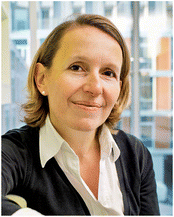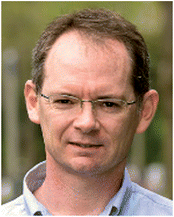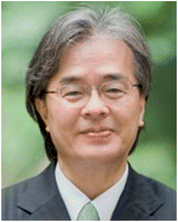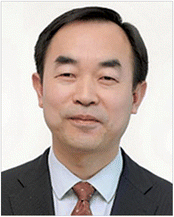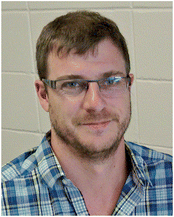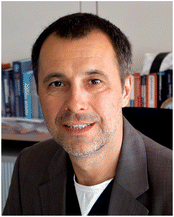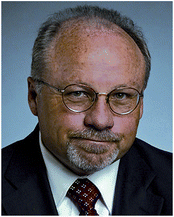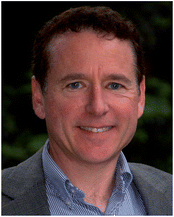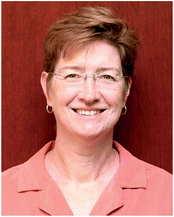Analyst Editorial Board profiles
Duncan Graham
Duncan Graham is Research Professor of Chemistry and director of the Centre for Molecular Nanometrology at the University of Strathclyde in Glasgow. He has been accorded numerous awards for his research including the Royal Society of Chemistry's SAC Silver Medal (2004), a Corday-Morgan Prize (2009), a Royal Society Wolfson Research Merit Award (2010) and was elected to the fellowship of the Royal Society of Edinburgh (2008). He is also a co-founder and director of Renishaw Diagnostics Ltd (2007). He completed his PhD in organic chemistry at the University of Edinburgh (1996) and now his interests are in using synthetic chemistry to produce nanosensors that respond to a specific biological species or event as measured by surface enhanced Raman scattering (SERS). He has a research group of around 30, and over 170 publications to date.
Julia Chamot-Rooke
Julia Chamot-Rooke received her PhD from Pierre et Marie Curie University in 1996. Following post-doctoral positions at the University of Copenhagen and the University of Amsterdam, she joined the CNRS as a junior scientist at the beginning of 1998. She worked in the Department of Chemistry at the École Polytechnique until 2012 where she mainly used FT-ICR (Fourier Transform Ion Cyclotron Resonance) Mass Spectrometry to study peptides and proteins. In September 2012 she moved to the Institut Pasteur Paris, as head of the newly created Structural Mass Spectrometry and Proteomics Unit. Her research focuses on the development of new methodologies, such as top-down mass spectrometry, for the structural analysis of proteins and protein complexes of high interest to human health. She is a past president of the French Society of Mass Spectrometry (2008–2009) and received the Prize of the Analytical Division of the Société Chimique de France in 2010. She was appointed a senior scientist by the CNRS in 2010.
Justin Gooding
Justin Gooding is the leader of the Biosensors and Biointerfaces research group at the University of New South Wales. He obtained a DPhil from Oxford University under the guidance of Professor Richard Compton before becoming a post-doctoral research associate at the Institute of Biotechnology at Cambridge University. In 1997 he returned to his native Australia as a Vice-Chancellor Post-Doctoral Research Fellow at the University of New South Wales before taking up an academic position in 1998. He was promoted to full Professor in 2005 and is currently an Australian Research Council Professorial Fellow. His research interests lie in biosensors, biointerfaces and surface chemistry.
Takehiko Kitamori
Takehiko Kitamori is Vice President of the University of Tokyo, responsible for Human Resource Development and Internationalization after serving as Dean of Faculty and Graduate School of Engineering. He is also a Professor in the Department of Applied Chemistry. Prior to joining the University of Tokyo in 1989, he was a researcher at Hitachi's Energy Research Lab. Professor Kitamori was the recipient of the Japan Society for Analytical Chemistry Award in 2009, the IBM Faculty Award in 2008, and the Chemical Society of Japan Award for Creative Work in 2006, as well as various other awards. He served as a senior vice president of The Japan Society for Analytical Chemistry (2006–2008). His areas of research are Micro/Extended-Nano Fluidics, Integration of Chemical System on Microchips, Applied Laser Spectroscopy for Ultrasensitive Detection, Analytical Chemistry, and Extended-Nano Space Chemistry.
Lanqun Mao
Lanqun Mao is currently a professor at the Institute of Chemistry, Chinese Academy of Sciences. He has been working at the interface between analytical chemistry and neuroscience including in vivo electrochemistry, biofuel cells, and in vivo microdialysis. He obtained his PhD at East China Normal University in 1998 and then worked in BAS Inc. Japan as a research scientist (1998–2000) and pursued post-doctoral studies at the Department of Electronic Chemistry at the Tokyo Institute of Technology (2000–2002). He has authored/co-authored more than 130 peer-reviewed publications. He is a recipient of the ‘Hundred Distinguished Young Scholars’ from the Chinese Academy of Sciences (2002) and the ‘National Distinguished Young Scholars’ from the National Natural Science Foundation of China (2006).
Jean-François Masson
Jean-François Masson holds a PhD (2005) in Analytical Chemistry from Arizona State University for his research on chemical and biological sensing with Surface Plasmon Resonance (SPR). During a post-doctoral fellowship at the Georgia Institute of Technology (2005–2007), he specialized in electrochemical sensing devices for medical applications, in collaboration with The Johns Hopkins Hospital. Since 2007, he has been a Professor of Analytical Chemistry at the University of Montreal focusing on the development of plasmonic devices for sensing in clinical samples. In 2013–2014, he was a visiting research scientist at the Max Planck Institute for Intelligent Systems. Specifically, his group has developed new plasmonic materials and surface chemistries for SPR sensing of proteins and therapeutic drugs in biofluids. His group has successfully integrated and validated a small SPR sensing device for monitoring methotrexate in the serum of patients undergoing chemotherapy. His research has resulted in the filing of eight patents and he has published more than 60 research articles. He has received prestigious awards, including the Fred Beamish Award (Canada), the Alexander von Humboldt Fellowship (Germany), and the Tomas Hirschfeld Award (USA). He is a member of the Executive Committee of the Analytical Division of the Canadian Society of Chemistry and serves on the long-range planning committees of FACSS and SCIX.
Pavel Matousek
Pavel Matousek obtained his MSc and PhD degrees in physics from the Czech Technical University (Prague). For over 20 years, he has worked at the Rutherford Appleton Laboratory (Oxford, UK) in the area of vibrational spectroscopy. He pioneered Spatially Offset Raman Spectroscopy (SORS) for the non-invasive probing of turbid media and is currently developing this concept for non-invasive disease diagnosis, applications in aviation security, cultural heritage and pharmaceutical quality control. Pavel has published over 180 peer-reviewed articles and filed ten patents. His honours include the premier Royal Academy of Engineering's 2014 MacRobert Award, the 2009 Charles Mann Award for Applied Raman Spectroscopy (FACSS), the 2002 and 2006 Meggers Awards from the Society for Applied Spectroscopy (SAS) and the 2008 Measurement in Action Award (IET). In 2008, Pavel co-founded a spinout company, Cobalt Light Systems, to commercialise the SORS technology. Its non-invasive analysers are now deployed at over 65 airports across Europe and 9 out of 10 of the largest pharmaceutical companies. In 2014 Cobalt was ranked the 10th fastest growing UK tech company by The Sunday Times Hiscox Tech Track 100. He is a Fellow of the Royal Society of Chemistry, a Fellow of the SAS, a Senior Fellow of the Science and Technology Facilities Council, an Honorary Professor at University College London and a board Director (CSO) of Cobalt Light Systems.
Boris Mizaikoff
Boris Mizaikoff received his PhD in Analytical Chemistry at the Vienna University of Technology (Austria) in 1996. In 1997, he joined the University of Texas (Austin, USA) as a post-doctoral Fellow. In October 2000, he finalized his Habilitation at the Vienna University of Technology and became a tenured faculty member at the School of Chemistry and Biochemistry, Georgia Institute of Technology (Atlanta, USA) heading the Applied Sensors Laboratory (ASL). In 2004, he became the Director of the Focused Ion Beam Center (FIB2 Center) at Georgia Tech. In fall 2007, he joined the faculty at the University of Ulm (Germany) as a Chaired Professor and Director of the Institute of Analytical and Bioanalytical Chemistry. His research interests focus on optical chem/bio-sensors, tailored (bio)molecular recognition interfaces, system miniaturization and integration, and multifunctional (nano)analytical techniques with applications in environmental, process, and biomedical diagnostics. He is author/co-author of over 200 peer-reviewed publications, 14 patents and numerous invited contributions at scientific conferences.
Steven Soper
Steven A. Soper graduated with a PhD from the University of Kansas in 1989 and then served as a post-doctoral Fellow at Los Alamos National Laboratory. He joined the faculty at Louisiana State University (LSU) in 1991 and was named the William L. & Patricia Senn Professor in 2002, alongside positions as Professor of Mechanical Engineering and an adjunct Professor of Biological Sciences. In June 2011 he joined the University of North Carolina's Joint Department of Biomedical Engineering as a tenured Professor. Professor Soper's research focuses on BioMEMS/BioNEMS, single-molecule detection, and new bioassay developments. He has received various awards, such as the R&D 100 Award (1993), the Charles E. Coates Award for Contributions to Chemical/Engineering Research in Louisiana (2001), the A. A. Benedetti-Pichler Microchemical Award (2006) and an LSU Distinguished Research Award (2008). He has accumulated over 225 peer-reviewed research publications and has mentored 30 PhD students.
Evan Williams
Evan Williams received his PhD from Cornell University in 1990 and completed a Postdoctoral Fellowship at Stanford University before joining the faculty at the University of California at Berkeley, where he also serves as the Associate Director of the Center for Analytical Biotechnology and the Faculty Director of the QB3/Chemistry Mass Spectrometry Center. He also holds a joint appointment in the Earth Sciences Division at the Lawrence Berkeley National Laboratory. Professor Williams's research group is developing and applying novel instrumental and computational techniques in mass spectrometry, tandem mass spectrometry, separations, and laser spectroscopy for improved molecular structure elucidation, and to solve problems of fundamental interest in chemistry and biophysics. A number of different types of state-of-the-art mass spectrometers and lasers are used in these studies. Recent honors include the American Chemical Society Field and Franklin Award in 2014, the Royal Society of Chemistry Theophilus Redwood Award in 2014 and the American Society for Mass Spectrometry Ron Hites Award in 2014.
Vicki Wysocki
Vicki Wysocki received her PhD from Purdue University and, following post-doctoral positions at Purdue and the US Naval Research Laboratory, became an Assistant Professor at Virginia Commonwealth University. She joined the University of Arizona in 1996 and served as Chair of the Department of Chemistry and Biochemistry. In 2012 she moved to Ohio State University where she is Ohio Eminent Scholar of Macromolecular Structure and Function and Director of the Campus Chemical Instrument Center. In 2009, she received the Distinguished Contribution to Mass Spectrometry Award from the American Society for Mass Spectrometry, jointly with Professor Simon Gaskell. Professor Wysocki's research interests include bioanalytical mass spectrometry, peptide fragmentation mechanisms, proteomics biomarker discovery and disease diagnosis using proteomics methods, and instrument development for improved dissociation and characterization of non-covalent protein complexes.
| This journal is © The Royal Society of Chemistry 2015 |


